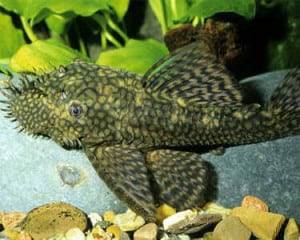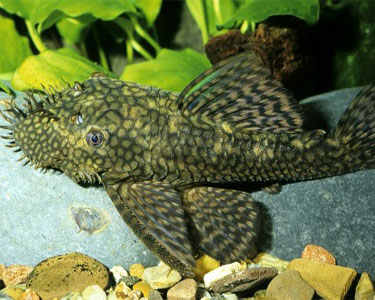
Common name: Bushy Nose Plecostomus, Bushy nose catfish, Bristlenose catfish, Bristlenose plec and Bushynose pleco.
Scientific name: Ancistrus Temminckii, Ancistrus Specie
Average Adult Fish Size: 4 inches / 12 cm
Place of Origin: A large part of South America
Typical Tank setup: S. American biotope with rocks, bogwood/driftwood, and plants along with a moderate to strong current.
Recommended Minimum Aquarium Capacity: 10 gallon / 40 litre
Compatibility: Peaceful. A good algae eater that will not usually harm even the smallest fish. Does not eat live plants, just the algae on them.
Temperature: 71 – 80 Deg. F / 22 – 27 Deg. C
Water chemistry: pH 5.8 – 7.5
Feeding: The Bushy nose pleco is an omnivore species, but the bulk of its diet should always consist of vegetable matter. Canned green beans, spinach, lettuce, blanched zucchini, and cucumbers are all relished. Only give your Bushy Nose Pleco occasional treats in the form of live or frozen meaty foods. Algae wafers, spirulina based pellets, and flakes make up a good staple diet.
Sexing: Females sometimes develop head tentacles just like the males, but the head tentacles are normally much more pronounced in the males and most females lack head tentacles altogether.
Breeding: Ancistrus is relatively easy to breed. In the wild, Bushy nose plecos tend to breed when the rainy seasons starts after the dry season. If your Bushy nose plecos are reluctant to spawn you can therefore try to mimic a dry season and the onset of the rainy season in the aquarium. They will usually spawn in a cave or upturned clay flower pot.
The Bushy Nose Pleco produces yellow or orange eggs that are guarded and cared for by the male. The male will prevent fungi attacks by fanning fresh water over the eggs and should therefore never be removed from the eggs. The eggs normally darken and hatch after roughly five days. The fry stay close to the spawning site and are guarded by their father. When the yolk sac has been consumed, start feeding with blanched lettuce or canned green beans. Older fry can eat newly hatched brine shrimp and algae wafers. Ancistrus fry are sensitive to organic waste, so frequent water changes are of vital importance.
Additional Information: As with all plecostomus type fish, use a soft, fine mesh net to catch them. Their numerous spines and sharp fins will get stuck in an ordinary coarse net. Bogwood or driftwood in the aquarium is a requirement in order for this species to remain healthy. Bushy Nose are one of the very best plecostomus species for eating algae. A good current along with frequent partial water changes will go a long way toward keeping this pleco happy and healthy. This species is one of the few plecostomus that does not uproot or eat live plants. They are available in dark brown, beige, black, and albino coloration along with regular and long-finned varieties.


Related Posts
Croaking Gourami – Trichopsis vittatus
Benthochromis Tricoti
Large-eyed Mouthbrooder – Callochromis Macrops